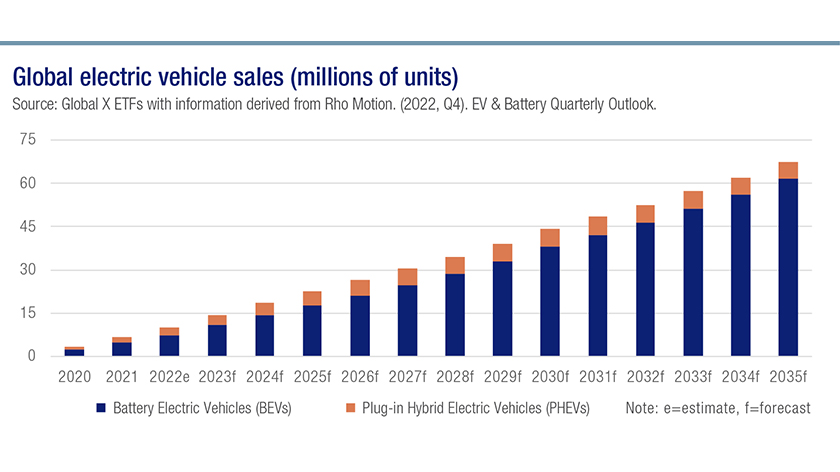EV-AV subsegments to watch
Five key segments stand to benefit as the world electrifies transportation and adopts AV technology:
- Electric vehicle manufacturers, including companies involved in the design, production or manufacturing of fully electric and hybrid cars, trucks, vans, motorcycles, scooters, buses, rail and aircraft.
- Electric vehicle technology and resources (EVTR) producers, such as manufacturers of electric drivetrains and powertrains, lithium-ion and other types of batteries, and fuel cells, as well as companies involved in the production of the raw materials that are essential to these technologies.
- Autonomous vehicle technology (ATV) developers, comprising companies that build autonomous vehicles, as well as those involved in developing specific AV technologies, such as lidar technology, driver assist technology, sensors, mapping and AI technology.
- Electric vehicle infrastructure (EVI) developers, including companies involved in the design, development or deployment of EV and AV infrastructure, such as electric vehicle charging stations and vehicle-to-grid (V2G) technology.
- Original equipment manufacturers (OEMs), with many of the traditional automakers expected to make battery EVs and hybrids a major part of their businesses.
A closer look at the investing opportunity in the EV-AV market
Several notable tailwinds support these robust growth outlooks. First, the U.S. government’s plan to increase electric cars supports EV transition around the world as policymakers look to decarbonize transport and mitigate climate change. Governments of major auto markets, such as the United States, China and Europe, are accelerating EV adoption through a variety of supportive policies and financial incentives. For example, in the United States, the Inflation Reduction Act included a tax credit of up to $7,500 for qualifying new EVs and up to $4,000 for qualifying used EVs.4 In addition, the Infrastructure Investment and Jobs Act commits $7.5 billion towards building out the country’s EV charging network.5
The Biden administration is targeting a network of 500,000 EV chargers in the U.S. by 2030.6 Building a robust EV charging infrastructure is as instrumental; falling EV costs improve consumer confidence to invest in an electric vehicle.
The regulatory landscape for autonomous vehicles also continues to evolve globally, although legislation lags the AV technology curve. In March 2022, the U.S. National Highway Traffic Safety Administration announced a final rule that removes the need for traditional manual controls, such as brakes and steering wheels, to be included in fully autonomous vehicles.7,8 However, robust federal regulation remains lacking for AVs in major countries, such as the U.S. As a result, a handful of states with supportive policies, such as Michigan, California and Arizona, have become hubs for innovation and advancements in self-driving technology.9
In addition, original equipment manufacturers and companies along the EV and AV supply chains are investing heavily to electrify their fleets and advance self-driving technology. EV producers are looking to expand their product offerings while improving battery technology and performance. According to one estimate, automakers are planning to spend more than $1.2 trillion through 2030 on producing EVs, EV batteries, and the underlying raw materials.10 AV producers and related technology companies are aiming for the commercialization of Level 5 AV technology, which is the holy grail because the vehicle requires no human input. Forecasters expect automakers will invest nearly $50 billion in autonomous vehicle development through 2025.11
Finally, companies and governments alike are engaged in substantial efforts to boost the mining and production of critical EV materials and components. Both battery production and mining for minerals such as lithium will need to increase to meet forecasted demand. For example, the International Energy Agency forecasts lithium demand in 2040 could be between 13 to 42 times higher than 2020 levels.12
In Albemarle’s 2023 Strategic Update, the company boosted its 2030 lithium demand outlook by 15% from its previous estimate, due to expectations for strong EV demand. As a result, several prominent lithium miners, including Albemarle, and junior miners, such as Sigma Lithium, are exploring mining and refining capacity expansion plans.13,14
In addition, EV battery producers, including GM and LG Energy Solutions, are also expanding production capacity.15 Notably, the U.S. has seen an uptick in battery manufacturing facility announcements following the passage of the Inflation Reduction Act, which includes government incentives for domestic manufacturing.16





